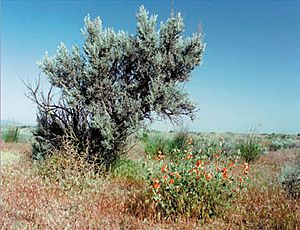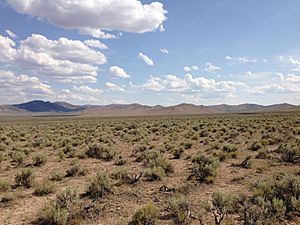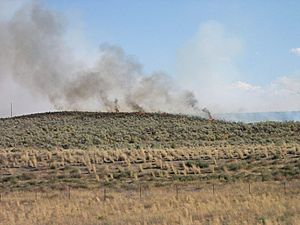Shrub-steppe facts for kids
A shrub-steppe is a special kind of grassland that doesn't get much rain. Even though it's dry, it has enough water for perennial grasses and shrubs to grow. This is what makes it different from a desert.
Two main natural events shape shrub-steppe areas: drought (very dry periods) and fire. Plants in the shrub-steppe have learned to live with little rain and dry summers. How much water is in the soil also affects where different plants can grow. Frequent fires help create a mix of shrubs and grasses across the land.
Contents
Shrub-Steppes in North America
North America's shrub-steppes are found in the western parts of the United States and Canada. They are located in the "rain shadow" between the Cascade Range and Sierra Nevada mountains to the west, and the Rocky Mountains to the east.
These areas stretch from southern British Columbia down through Washington, Oregon, and California. They also cover parts of Idaho, Nevada, Utah, Wyoming, Colorado, New Mexico, and Arizona.
Plants of the Shrub-Steppe
The main plants here are low-growing shrubs. These include big sagebrush (Artemisia tridentata) and bitterbrush (Purshia tridentata). There isn't enough rain for large forests to grow, but some trees can be found.
Other important plants are bunchgrasses, like Pseudoroegneria spicata. Historically, these grasses provided food for animals and livestock. However, new plants like cheatgrass (Bromus tectorum), tumble mustard (Sisymbrium altissimum), and Russian thistle (Salsola kali) are taking over. These new plants are not native to the area.
Animals of the Shrub-Steppe
Many animals call the shrub-steppe home. Some examples include the sage grouse, pygmy rabbit, Western rattlesnake, and pronghorn. These animals have adapted to live in this dry environment.
Unique Landscapes and Challenges
In Washington state, much of the shrub-steppe was once called "scabland." This name came from the deep channels carved into the basalt rock by huge floods over 10,000 years ago.
Today, shrub-steppe ecosystems face several threats:
- Overgrazing: Too many animals eating the plants can harm the land.
- Fires: Fires can destroy native plants that are not adapted to burn often.
- New Species: Non-native plants can take over and push out the original plants.
- Development: As towns and cities grow, they build on shrub-steppe land.
- Farming: Some areas are turned into farmland.
- Energy Projects: Building things like wind farms or oil wells can also impact the land.
In Washington state, less than half of the original shrub-steppe remains. Some experts believe only about 12% to 15% is left.
Major Shrub-Steppe Regions
Here are some of the main shrub-steppe regions in North America:
- Great Basin shrub steppe: Found in eastern California, central Nevada, western Utah, and southeastern Idaho.
- Snake–Columbia shrub steppe: Located in south-central Washington, eastern Oregon, northeastern California, northern Nevada, and Idaho.
- Wyoming Basin shrub steppe: Covers central Wyoming, and parts of Montana, Utah, Idaho, and Colorado.
- Okanagan shrub steppe: Found in the Okanagan Valley and southern Similkameen Country in British Columbia and northern Washington.




